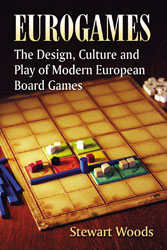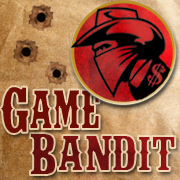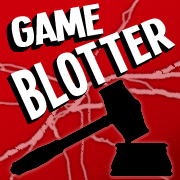Welcome to Purple Pawn, covering games played around the world by billions of people every day.
 Eurogames by Stewart Woods (2012, McFarland & Company)
Eurogames by Stewart Woods (2012, McFarland & Company)
Summary
A nice introduction to Eurogames and to some game studies topics in general. Well written, accessible, covers the topic without much industry detail. Could have used more about specific Eurogames and its culture and less about other topics.
Overview
Eurogames is around 200 pages, excluding 50 pages of preface, introduction, end-notes, and bibliography.
 Chapters 1 to 4 (about 70 pages) cover the history of board games in general and Eurogames in particular. The history does not reach back to ancient cultures, but sticks mostly with modernity. After dividing games into classic, mass-market, and hobby games, hobby games are then divided into genres, each with a short history. The book analyzes the origins of Eurogames in America and Germany and briefly mentions game awards and conventions.
Chapters 1 to 4 (about 70 pages) cover the history of board games in general and Eurogames in particular. The history does not reach back to ancient cultures, but sticks mostly with modernity. After dividing games into classic, mass-market, and hobby games, hobby games are then divided into genres, each with a short history. The book analyzes the origins of Eurogames in America and Germany and briefly mentions game awards and conventions.
Chapter 5 (40 pages) categorizes Eurogames, mostly through mechanics, with a brief introduction as to how the categories were chosen. This section also includes talk about elements, rules, mechanics, goals, themes, information aspects, chance, and the end-conditions of Eurogames.
The remaining 95 pages discuss players and the motivations behind play. They spend a lot of time on a 2007 survey of BoardGameGeek users conducted by the author, giving us the makeup of a typical circa-2007 BGG user (one type of Eurogamer). They discuss collecting games and the relationship that gamers have with publishers and designers.
Why gamers play is then discussed, including an overview of “flow”, social interaction, luck, and the other elements of games that are fun, as well as goals, and the tension between fun and striving to win. Social problems with games (such as cheating) are also discussed. The book concludes with a few pages on games and culture.
Reactions
This book is aimed at the general public, i.e. not academic and not business. It is easy and friendly, and covers the general idea of Eurogames very well. It also covers, slightly more than necessary, various topics in game studies: what gamers are like, why people play games and why they cheat. These topics are covered in order to flesh out the idea of the kind of person who plays Eurogames, but the analysis really applies to any gamers of any genre, and even to anyone who plays games at all.
It’s a fair survey of these topics; for more depth, you can read many of the titles referenced in the bibliography. I found the topics to be only peripherally concerned with Eurogames and gamers, and so were not really necessary. Instead, I felt that the book should have spent more time going into depth about certain Eurogames.
For example, a couple of pages on how Settlers of Catan or Ticket to Ride was designed, how it is played, how the mechanisms interact, and how sessions go. Maybe focus on a dozen other popular games. Also missing were details about the game industry; how the industry arose in general is covered, with mentions of Z-Man Games, Rio Grande Games, Mayfair Games, etc, but not a look at real facts about the current game industry: number of companies, profits, distribution, penetration, country statistics, etc.
I say this only FYI. You can’t blame a book for what it’s not trying to be.
The book provides good coverage of many parts of the social scene of the die-hard gamers: the early Internet groups, the awards, the evangelists, and so on. It includes many quotes from BGGers on every topic from what makes a game fun to what makes a game serious.
One problem I fault the book for is that its data about gamers and their motivations comes from a voluntary survey of BoardGameGeek users. I don’t think that BGG users necessarily represent Eurogamers, or even gamers, in general. They are a certain type of active social gamer/collector, and tend to have a myopic view of the world. In my own town of about 40,000 people, only a handful of people come to game nights and have BGG accounts, but dozens or even hundreds play or have played a Euro or hobby game.
Nevertheless, I enjoyed the read. Those of you who are unfamiliar with the history of modern hobby games, or with the various topics covered, such as what makes a gamer enjoy games, will find this book to be a pleasant overview and a nice read.
A complimentary copy of Eurogames was provided for review.
No Comments
Sorry, the comment form is closed at this time.
Trending
- Are Board Games Dangerous?
- USPS Adds Board Game Flat Rate Box
- Home
- The Truth About Dominoes On Sunday in Alabama
- 2014 Ticket to Ride World Champion Resigns Title After Cheating Revealed
- Storing Story Cubes
- Card Dealing Machines for Bridge
- Anti-Bullying Board and Card Games
- Second Look — Heroes of Graxia
- Master Malaysia, Designed by Committee
Archives
Most Popular Articles
- The 20 Most Valuable Vintage Board Games
- USPS Adds Board Game Flat Rate Box
- Sequence Game, and Variants
- Baila, the Estonian Drinking Card Game
- The 13 Most Popular Dice Games
- The Truth About Dominoes On Sunday in Alabama
- The Convoluted Story of Iron Wind Metals, Ral Partha, and Battletech Miniatures
- Oh the Irony—Illuminati Card Game Continues to Inspire Conspiracy Theorists
- Are Board Games Dangerous?
- Guess Who? The Naked Version
Recent Posts
- Toy Fair 2019—Breaking Games
- Talisman Kingdom Hearts Edition
- Toy Fair 2019—Winning Moves
- Toy Fair 2019—Games Workshop
- Toy Fair 2019—Star Wars Lightsaber Academy
- Toy Fair 2019—Stranger Things Games
- Toy Fair 2019—HABA
- Licensing Roundup
- Game Bandit
- 2018 A Difficult Year For Hasbro But Not For D&D Or MtG
Recent Comments
- on Toy Fair 2019—Winning Moves
- on Game Bandit
- on Second Look—Dungeons & Dragons Waterdeep Dragon Heist
- on Crowdfunding Highlights
- on Beyblade SlingShock
- on Game Bandit
- on Game Bandit
- on Watch This Game!, the Board Game Review Board Game
- on Second Look—Vampire: The Masquerade 5th Edition
- on Palladium Books Loses Robotech IP License, Cancels Five-Year-Overdue Robotech RPG Tactics Kickstarter



